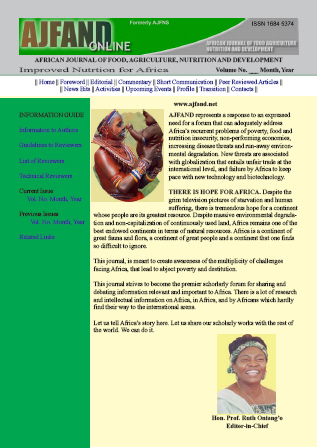
|
African Journal of Food, Agriculture, Nutrition and Development
Rural Outreach Program
ISSN: 1684-5358
EISSN: 1684-5358
Vol. 3, No. 1, 2003
|
 Bioline Code: nd03004
Bioline Code: nd03004
Full paper language: English
Document type: Research Article
Document available free of charge
|
|
|
African Journal of Food, Agriculture, Nutrition and Development, Vol. 3, No. 1, 2003
| en |
EXAMINATION OF URINARY IODINE STATUS FROM A SAMPLE OF MALIAN ADOLESCENT GIRLS
Pawloski LR, Shier NW, Fernandez XE and PL Jamison
Abstract
Iodine deficiency disorders are common throughout the developing world, yet they are considered one of the most preventable causes of mental retardation. Iodine deficiency has tremendous consequences on women and girls and can not only impair a woman's reproductive health, but it also has serious consequences for a growing fetus. In pregnant women, this deficiency can lead to congenital hypothyroidism in newborn infants. Congenital hypothyroidism is a disorder associated with a low IQ, deaf mutism, and neurological problems. Many studies have revealed that iodine deficiency is common throughout West Africa. While several of these studies have investigated the prevalence of iodine deficiency among women in West Africa, few have examined the problem among adolescent girls. Thus this study aimed to quantify iodine levels in a representative sample of adolescent girls aged 10 to 15 years from the Segou Region of Mali, West Africa. Casual urine samples were collected, and urinary iodine excretion was analyzed using the Sandell-Kolthoff reaction. Clinical signs of iodine deficiency, the presence or absence of goiters, were noted and ethnographic interviews were conducted to examine dietary behaviors. Mean urinary iodine excretion was 9.3 μg iodine/dl (95% CI 7.6-10.9). Forty girls were iodine deficient (66.6%, 95% CI 53.3-78.3) of whom 19 (31.7% CI 20.3-45.0) showed moderate or severe deficiency. These results show that the majority of these Malian adolescent girls are at a mild to moderate risk for iodine deficiency, however no statistically significant differences were found between girls from the urban and rural communities. These findings suggest that not only can iodine deficiency affect the individual health of these girls, but iodine deficiency can have many ramifications concerning the socioeconomic status of their communities. Because adolescent girls are still growing and preparing to have children, these findings have major implications for their health and the health for their future children. These results provide one of the first analyses concerning iodine deficiency among adolescent girls in Mali.
Keywords
Iodine deficiency, Mali, nutrition, adolescent girls
|
| |
| fr |
EXAMEN DU NIVEAU D'IODE URINAIRE A PARTIR D'UN ECHANTILLON DE FILLES ADOLESCENTES MALIENNES
Pawloski LR, Shier NW, Fernandez XE and PL Jamison
Résumé
Contexte : Les troubles dus à la carence en iode sont courants dans le Tiers-monde. Chez les femmes, cette carence peut conduire à un hypothyroïdisme congénital avec des troubles de croissance chez les nouveaux-nés, associés à un bas Q I et une surdité et aphonie.
But : Cette étude avait pour but d'évaluer de façon quantitative, le niveau d'iode dans un échantillon représentatif de filles âgées de 10 à 15 ans au Mali (Afrique de l'ouest).
Méthode : Des échantillons d'iode ont été collectés dans la région de Ségou au Mali et l'iode contenu dans l'urine a été analysé en employant le réactif Sandell-Kolthoff. La présence ou absence de goitre ont été notée et des enquêtes ethnographiques conduites pour examiner leurs habitudes alimentaires.
Résultats: le taux moyen d'iode retrouvé dans les urine étaient de 9,3mg iode /dl (95% IC 7.6 - 10, 9 ) quarante filles avaient manifesté une déficience en iode (66,6% , 95% IC 53,3-78,3) parmi lesquels dix neuf (31,7% IC 20,3 - 45.0) ont manifesté une carence modérée ou sévère.
Discussion: Ces résultats démontrent que la majorité de ces adolescentes maliennes courent un risque plus ou moins grand de carence en iode. Ces résultats fournissent l'une des premières analyses concernant la carence en iode chez les adolescentes du Mali. Etant donné que les adolescentes sont en pleine croissance et en âge de procréer, ces découvertes ont des implications majeures pour leur santé et celle de leur futurs enfants.
Mots Clés
carences en iode, le Mali, nutrition, adolescentes
|
| |
© Copyright 2003 -Rural Outreach Program
Alternative site location: http://www.ajfand.net/
|
|
